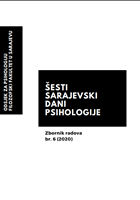Neke odrednice počinjenog nasilja u školi i susjedstvu
Some Determinants of School and Neighborhood Violence Perpetration
Author(s): Elma Omersoftić, Sibela Zvizdić MecoSubject(s): Educational Psychology, Social psychology and group interaction, Behaviorism, Studies in violence and power, Sociology of Education
Published by: Filozofski fakultet Univerziteta u Sarajevu
Keywords: violence perpetrated in school and neighborhood; early adolescents; aggressiveness; parental control;
Summary/Abstract: Exposure to the community violence (at school and in neighborhood) as a perpetrator can leave negative and long term consequences for direct victims, witnesses and perpetrators, but also for all local community. Therefore, the goal of this research was was to inquire relationship between some determinants (gender, aggressiveness, depressive reactions, self-esteem, parental control, perceived social support from family, peers and teachers) from one side and early adolescent’s violence exposure as a perpetrator in school and neighborhood on the other side. It was anticipated that significant predictors of perpetrated community violence (at school and in the neighborhood) would be male gender, higher level of aggressiveness and depressive reactions, lower level of self-esteem, lower level of parental control, lower level of perceived social support from family, peers and teachers. Next instruments were applied on a sample of 300 younger adolescents (160 girls and 138 boys, two participants who did not specify their gender), average age 12.97 (SD=1.17): Scale of aggression; Birleson’s depression scale; Rosenberg’s Self-esteem Scale; Parental control scale; Scale of perceived social support; Victimization Scale from which was used a Scale of exposure to violence in school as a perpetrator and a Scale of exposure to violence in the neighborhood as a perpetrator. According to the results of the logistic regression analysis it was established that the regression model explains 28,3% of the variance criteria of community violence exposure as a perpetrator of violence at school and the omnibus test model is statistically significant. Moreover, at the basis of second logistic regression analysis, it was established that regression model explains 15,7% of the variance criteria of community violence exposure as a perpetrator of violence in the neighborhood, and the omnibus test model is statistically significant. Predictor variable which has the highest and greatest contribution in prediction of perpetrated violence at school and neighborhood is aggressiveness. Responsibility of the local community refers to possibility of identification and early recognition of the determinants of younger adolescents’s perpetration of violence at school and neighborhood and possibility of implication of revealed results of the research with the aim of planning and realization of long term interventions which would be directed to prevention of community violence and improvement of student’s mental health and their development into socially, emotionally mature and stable adult persons.
Journal: SARAJEVSKI DANI PSIHOLOGIJE: ZBORNIK RADOVA
- Issue Year: 6/2020
- Issue No: 6
- Page Range: 21-42
- Page Count: 22
- Language: Bosnian

